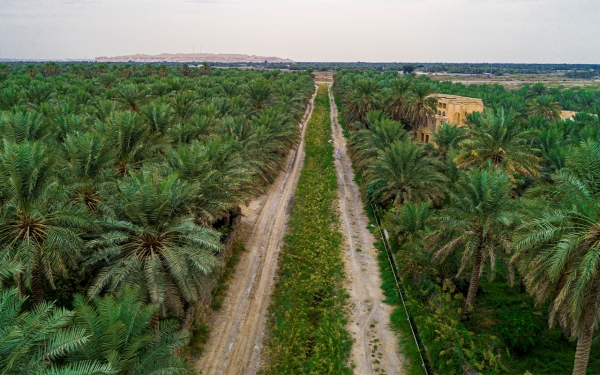
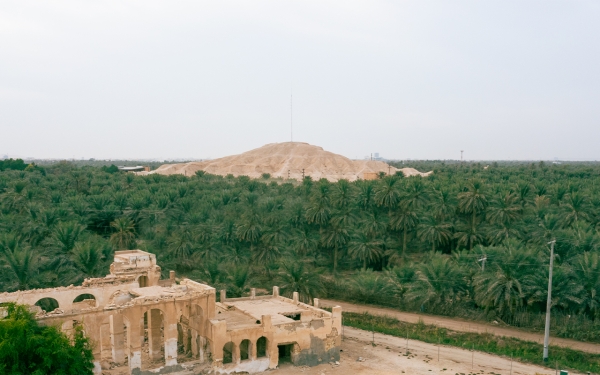
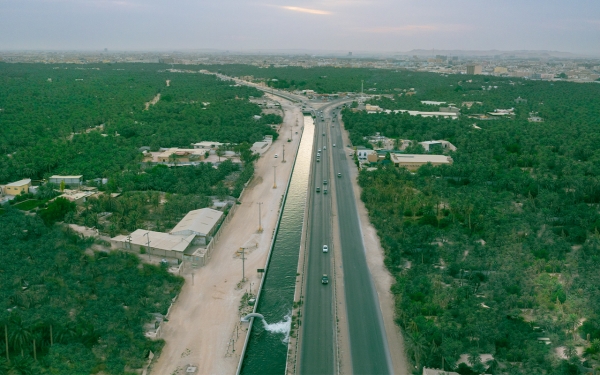
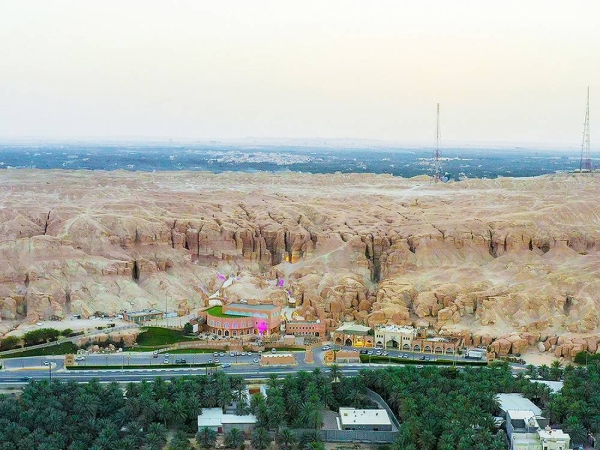
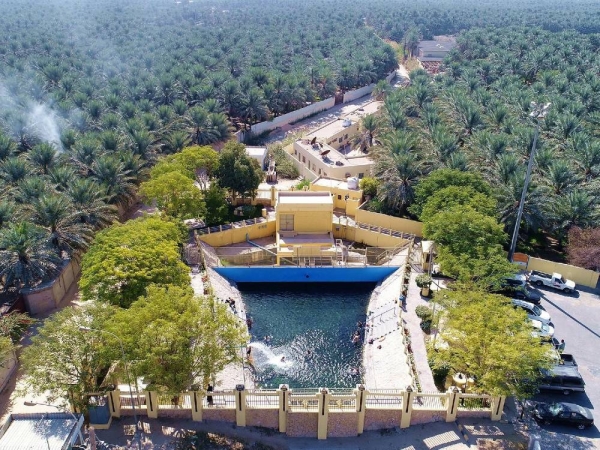
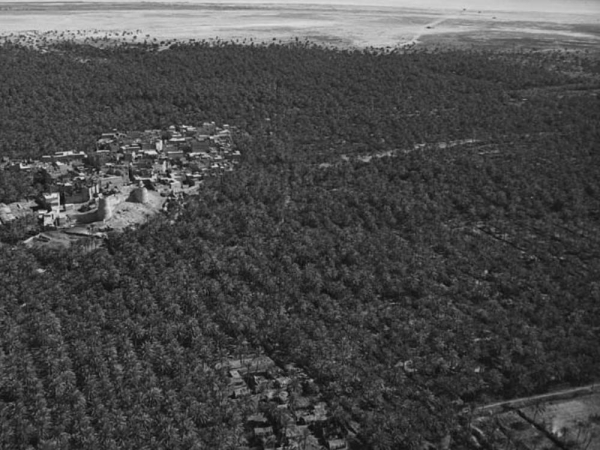
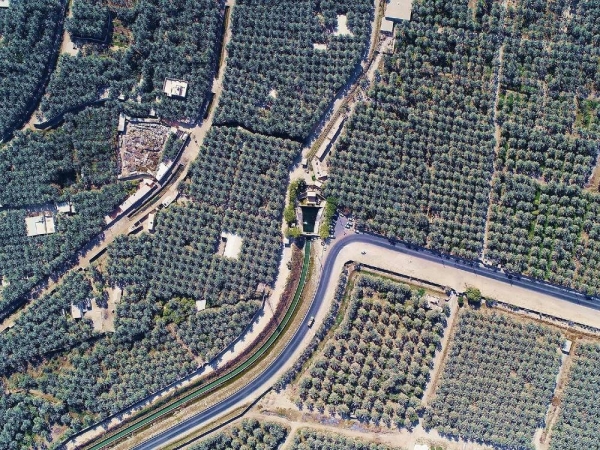
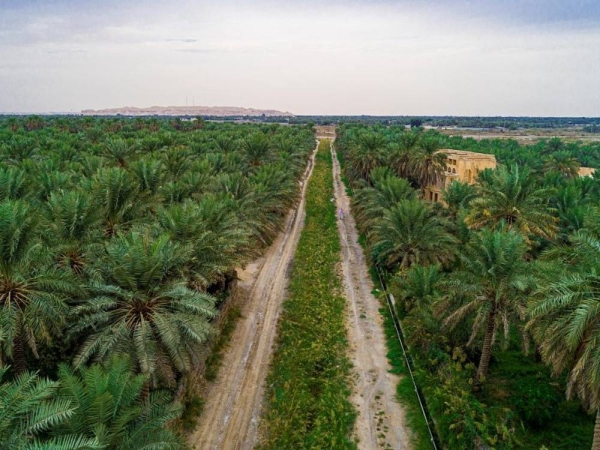
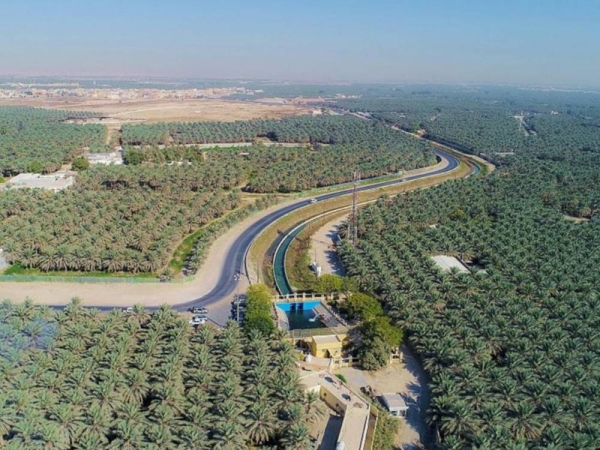
Al-Ahsa Oasis is a cultural world heritage site and a tourist cultural destination for the Kingdom of Saudi Arabia. Its fertile land, abundant palm trees, and water springs have made it the largest oasis of palm trees surrounded by sand in the world. It is the largest governorate in the Kingdom, covering an area of 375,000 km², and is one of the governorates in the Eastern Province, which is the largest province in the Kingdom with an area of 540,000 km². It is the fifth Saudi site to be inscribed on the United Nations Educational, Scientific and Cultural Organization (UNESCO) World Heritage List.
About al-Ahsa Oasis
Name origin
Locally, al-Ahsa Oasis is known as 'al-Hasa.' Al-Hasa is derived from the Arabic 'al-Hasi,' which refers to rocky land covered with a layer of sand that stores rainwater. Water can be obtained from it by digging to a very shallow depth. It was historically known as al-Ahsa, as mentioned by Yaqut in his book Mu'jam al-Buldan.
Location and borders
Al-Ahsa Oasis is the largest oasis in the Kingdom in terms of area. It is bordered to the north by the provinces of Buqayq,an-Nu'ayriyyah, and Qaryat al-Ulya, to the east by the Arabian Gulf, Qatar, and the United Arab Emirates, to the south by Sultanate of Oman, and to the west by ad-Dahna' Desert and as-Summan Plateau. It is located on the Ghawar Field, the world's largest oil field.
Economic resources
Al-Ahsa Oasis is described as the Eastern Province's food basket, renowned for producing dates, wheat, rice, and fruits. It is home to approximately three million palm trees. Therefore, the Saudi government encourages agriculture by improving profitability for farmers. The region also encompasses a camel market and a Thursday weekly market in al-Hufuf where agricultural products, such as dates, wheat, rice, and fruits, are also showcased. Additional economic activities in the region include textile manufacturing and the breeding of Arabian horses.
Al-Ahsa Oasis is also known for producing Hasawi rice, locally known as 'al-Aysh al-Hasawi,' which has been one of its essential agricultural crops since ancient times. The region experiences high temperatures reaching up to fifty °C during the summer, which is conducive to the cultivation of Hasawi rice. Hasawi rice is an annual herbaceous summer plant characterized by its red grains, with a length of up to ten mm. During its growth stages, it requires a temperature of forty-eight °C. It also needs abundant water and heavy clay soil with a slight acidity that retains moisture, conditions that are provided by the soil in al-Ahsa. Al-Ahsa farmers refer to the rice harvesting season as 'al-Wasmi,' which typically occurs between the months of September and October. It is considered a joyous time in al-Ahsa. The harvesting process is done manually, and the rice is left exposed to the sun for several days to dry. Following that, the process of winnowing or threshing takes place, which involves separating the husk from the original rice plant.
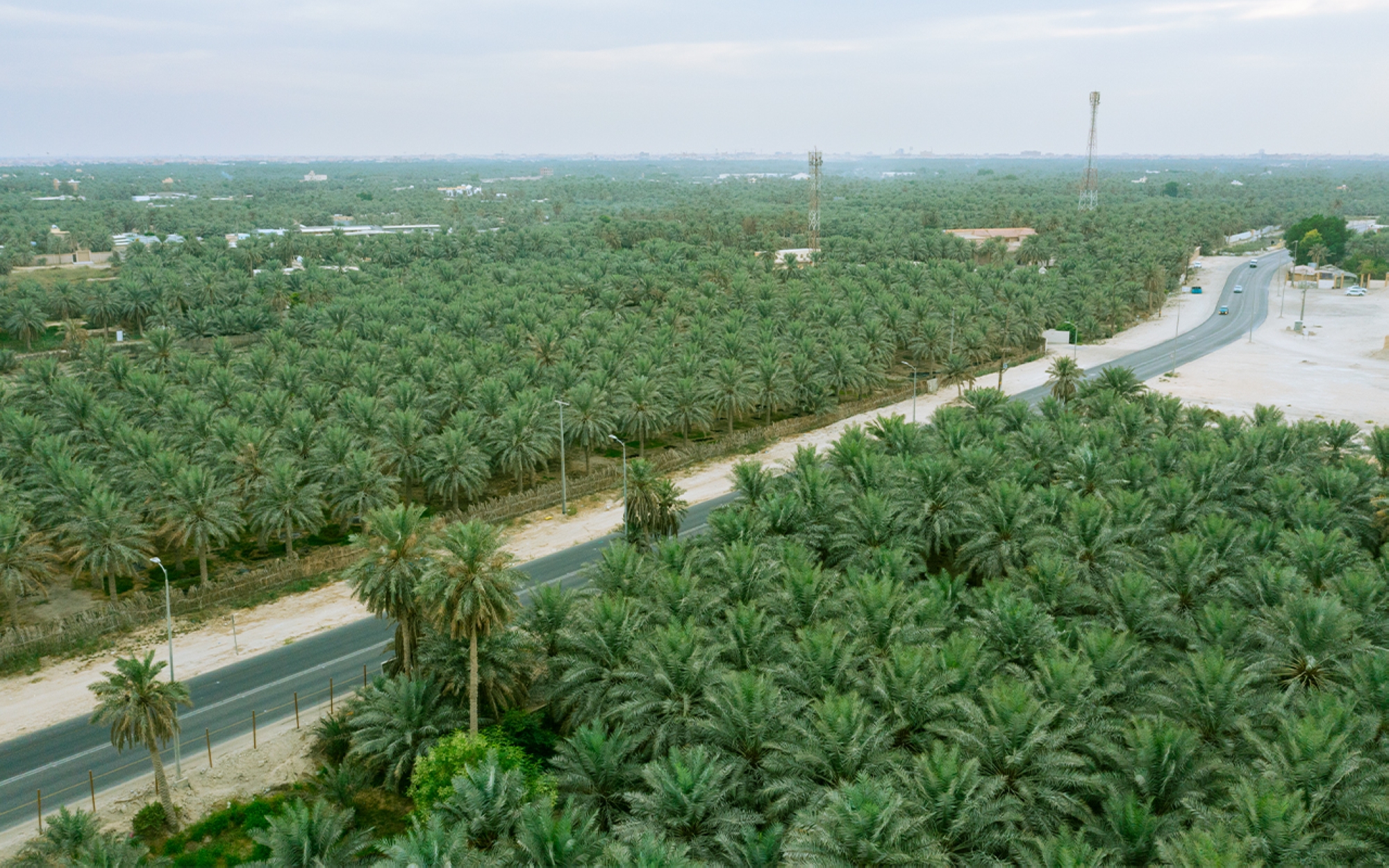
Al-Ahsa Oasis globally
Al-Ahsa Oasis on the World Heritage List
The permanent representative of the Kingdom to UNESCO submitted a request to register ten sites on the tentative list to the World Heritage Center at UNESCO. Subsequently, the Saudi Commission for Tourism and National Heritage (currently the Ministry of Tourism) prepared the registration file for al-Ahsa Oasis within the World Heritage List in 2015. An initial nomination file was crafted and submitted to UNESCO, under the name 'Al-Ahsa Oasis, an Evolving Cultural Landscape.' The nomination file for the site was submitted to the World Heritage Center in January 2017. After review, the file was accepted, and a copy was sent to the International Council on Monuments and Sites (ICOMOS) to initiate the file's field evaluation.
The registration of al-Ahsa Oasis on the World Heritage List went through several important stages. The General Authority for Tourism and National Heritage (currently the Ministry of Tourism) sent a team to the ICOMOS, to meet with the committee tasked with studying and discussing the nomination file in Paris. After studying and conducting field visits, the UNESCO World Heritage Center team made some observations regarding the site. A team was formed to address these observations, and every effort was made to ensure the success of the nomination file. The team worked in coordination and collaboration with the Municipality of al-Ahsa, with support and cooperation from businessmen and the local community, to address the observations and modify the existing situation of some buildings and projects to comply with the requirements of the ICOMOS concerned with preserving historical and heritage value and identity.
The General Commission for Tourism and National Heritage (currently the Ministry of Tourism) corresponded with the members of the World Heritage Committee, consisting of twenty-one countries, through the Ministry of Foreign Affairs. They were provided with a copy of the statement of Outstanding Universal Value. Additionally, the commission organized visits for them to al-Ahsa Oasis. Moreover, a team of experts was formed to oversee the final stages of registering the oasis on the World Heritage List. In June 2018, the UNESCO official delegation visited some environmental and heritage sites in the oasis. A presentation was given about the efforts of the higher and technical committees in preserving the elements of the oasis. The final step of the registration process took place during a meeting of the World Heritage Committee held in the capital of Bahrain, Manama, on June 29, 2018.
The significant and collaborative efforts have achieved success in registering al-Ahsa Oasis on the World Heritage List. The United Nations Educational, Scientific and Cultural Organization (UNESCO) issued a statement affirming that al-Ahsa Oasis is a natural, cultural, and heritage landscape, and an exceptional example of the interaction between humans and their surrounding environment, thus qualifying it for inclusion in the World Heritage List. The statement highlighted that this oasis, located in the eastern part of the Arabian Peninsula, is rich with gardens, irrigation channels, freshwater springs, and wells, and is home to al-Asfar Lake. It also features historical buildings, urban fabric, and archaeological sites that bear witness to human settlement and stability in the Gulf region from the Neolithic period to the present. The statement acknowledged the uniqueness of al-Ahsa Oasis as the world's largest date palm oasis.
Al-Ahsa Oasis in the Guinness World Records
In October 2020, al-Ahsa Oasis entered the Guinness World Records as the largest self-contained oasis in the world. It encompasses 2.5 million date palms nourished by a massive groundwater layer through 280 artesian wells, covering an area exceeding 85.4 km² (32.9 mi²), as documented on the Guinness World Records website. The Heritage Authority undertook the task of introducing al-Ahsa Oasis to the global encyclopedia.
List of UNESCO Creative Cities
Al-Ahsa has joined the UNESCO Creative Cities Network, a group of cities that have identified creativity as a strategic factor for sustainable urban development. This is in accordance with seven creative fields endorsed by the organization, which include: crafts and folk art, literature, music, culinary arts, film, media arts, and design. Al-Ahsa applied for nomination and became a member of the network in late November 2015, particularly in the field of crafts and folk art, which are abundant in al-Ahsa.
Arab Tourism Capital 2019
The Arab Ministerial Council for Tourism, in its twenty-first session held in Alexandria, with the presence of Arab tourism ministers, heads of organizations, and Arab federations, decided to designate al-Ahsa City as the Arab Tourism Capital 2019. This decision was made because al-Ahsa met all the reference conditions set by the Arab Tourism Organization, owing to the distinguished tourism elements of this historic oasis. During the reign of the Custodian of the Two Holy Mosques, King Salman Bin Abdulaziz Al Saud, and His Royal Highness, Crown Prince and Prime Minister, Prince Mohammed Bin Salman Bin Abdulaziz Al Saud, al-Ahsa underwent comprehensive advancement in various developmental facilities, including those related to tourism. This green oasis has been recognized by UNESCO as one of the world's heritage cities due to its wealth represented by its historical palaces, the historic mosque in Jawatha, and a series of important discoveries dating back thousands of years.
The historical, cultural, and tourist status of al-Ahsa paved the way for its selection as the Arab Tourism Capital. This designation enhances the increase and development of tourism revenues for al-Ahsa Governorate. Over recent years, al-Ahsa has seen the emergence of numerous tourism projects that have qualified it to become a prominent tourist destination in the near future, not just for the residents of the Eastern Province, the Kingdom's provinces, or Gulf countries, but also for tourists from around the world.
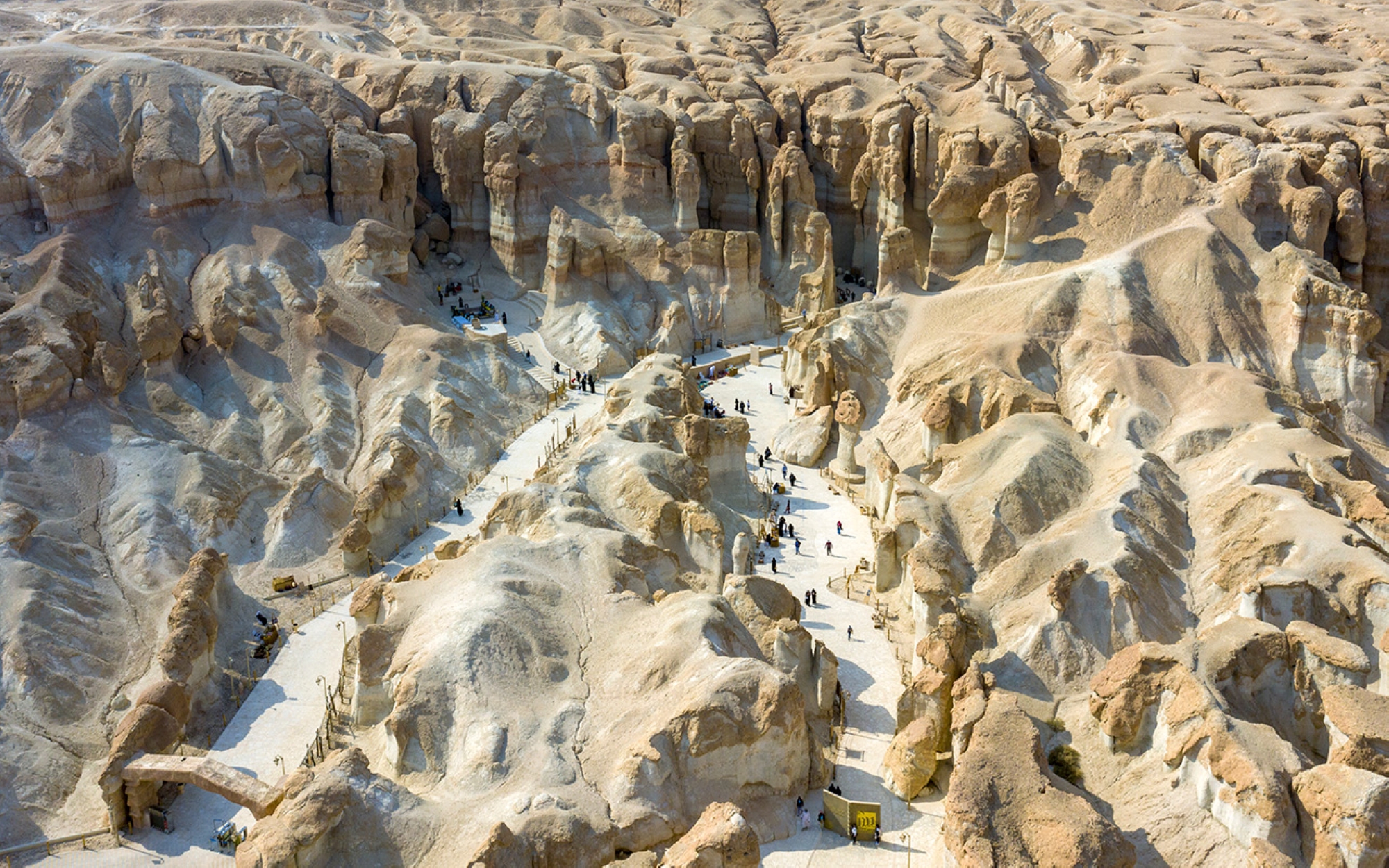
Natural landmarks in al-Ahsa Oasis
Al-Qarah Mountain
Al-Ahsa Oasis is known for the presence of a number of mountains, including prominent al-Qarah Mountain, Mountain, ash-Shu'bah Mountain, Bureiqah Mountain, al-Arba' Mountain, Abu al-Dalasis Mountain, and Abu Hasis Mountain. Al-Qarah Mountain, situated twelve km from al-Hufuf, is considered one of the most important tourist landmarks. Its base covers an area of fourteen km², and it reaches an elevation of about 45.72 m. It is surrounded by four villages: Al-Qarah, al-Twaitheer, al-Tuhaimiyah, and al-Dalwah. The grottoes of al-Qarah Mountain stand out for their extreme coolness in summer and warmth in winter. It is distinguished by its peculiar rock formations, and its caves vary in expansiveness and many resemble chambers. Among these grottoes is al-Naqa grotto with numerous caves. It is the most spacious and coolest, accommodating at least four hundred people. It includes an area called ‘al-Thalaja’ (the freezer) due to its intense coldness, featuring a minute opening called the ‘freezer.’ The grotto's visitors may need to bend, walk on their knees, or crawl in some areas. Additionally, there is the ‘Eid’ grotto and its entrance is located near the Sunday Market. It has wide entrances and does not require artificial lighting. It also features spacious elevated areas resembling Roman theaters, which visitors can easily access.
There is another grotto called 'al-Mayhoub,' known for its height, darkness, and its entrance close to the entrance of the 'Eid' grotto. Additionally, there is another grotto known as 'al-Maghara,' with its entrance situated between the villages of al-'Twaitheer' and 'al-Tuhaimiyah.' This cave is equipped with lighting. In the middle of al-Qarah, visitors can witness 'al-Mashqar,' also known as 'Ras al-Qarah,' a peculiarly shaped hill with a rich history dating back to the pre-Islamic era. Its name appears in historical and literary texts about the Arabian Peninsula. 'Al-Mashqar' was the residence of the kings of Kindah, one of the ancient Arabian kingdoms. 'Al-Mashqar,' one of Ayyam al-Arab (days of the Arabs), was mentioned in Arab poetry throughout history, with poets like Imru' al-Qais Bin Hujr al-Kindi referencing it. Another historical site is 'al-Safa,' which is now known as 'Abu Hasis Mountain.' It is located north of the village of al-Twaitheer, adjacent to al-Qarah Mountain.
Al-Asfar Lake
Al-Asfar Lake is located five km east of al-Umran in al-Ahsa. The lake is surrounded by various desert plants, and it hosts several fish species that can be observed. The lake serves as a resting stop for numerous migratory birds.
Al-Sifa Oasis
Al-Ahsa Oasis borders the central sector of al-Sifa Oasis in al-Hufuf, covering an area of approximately 1.08 km. It consists of densely planted date palm groves. The historical cemetery in al-Hufuf largely defines its eastern boundaries, while its shape is irregular in the western, northern, and southern directions. It is surrounded by a green belt with a depth of two hundred m, serving as a protective zone against neighboring urban hamlets.
The Northern Oasis
The Northern Oasis comprises a significant part of the northern al-Ahsa Oasis, with a total area of 20.1 km². It is bordered by the main drainage canal extending from the northeast to the south. The network of canals dating back to the 1970s forms the southern, western, and northern boundaries of the oasis. The site somewhat takes on a circular integrated shape, as if sculpted away from the previous central axis of the village of al-Qurayn and three large areas respectively on the southern, western, and northern sides, where the historical villages and their modern extensions are located.
Ain Qannas Site
Ain Qannas is located north of al-Ahsa Governorate, fifteen km from the city of al-Mubarraz, and northeast of the village of al-Marah, just 1.5 km away. Ain Qannas site is described as the largest site for the Ubaid civilization in the Kingdom. The surface is scattered with fragments of pottery that characterized the Ubaid civilization in the ancient Stone Age, covering an area of two km². Excavations for artifacts were conducted to a depth of five m below the ground surface, revealing the discovery of fourteen successive residential layers representing stages of human settlement at the site.
Human settlement history in al-Ahsa Oasis
The Modern Stone Age
Archaeological findings in al-Ahsa Oasis reveal a history dating back to ancient times, specifically to the Ubaid civilization in the Modern Stone Age. Discoveries include colored pottery pieces, which are known to have been crafted during the Ubaid era, particularly at the Ain Qannas Site.
The Bronze Age
The archaeological survey in al-Ahsa Oasis has revealed evidence of settlements dating back to the third millennium BCE, historically known as the Bronze Age. This discovery is based on the identification of a specific type of unmarked raw pottery known as 'Red-Edged Dilmun Pottery.' These are dark jars with a yellow hue, reflecting the pottery styles found in the Mesopotamian region.Similar pottery has been found in the tumulus fields south of Dhahran Airport, resembling the brittle black with reddish hue and red pottery discovered in the oases of al-Hufuf and Yabreen, as well as in the south of Buqayq.
Eras of Arab kingdoms and the Islamic Period
In the first millennium CE, the coasts and interior of al-Ahsa were settled by Arab tribes, such as Tasm, Jadis,and Bani Abdul Qais. When Islam arrived through the Prophet Muhammad peace be upon him (PBUH) the people embraced the Islamic religion during the reign of the governor, Al-Mundhir bin Sawi. Al-Ahsa remained under the rule of the Rashidun Caliphate, which governed the region after the death of the Prophet Muhammad (PBUH) and then under the Umayyad and Abbasid caliphates.
In 899, 'Abu Sa'id al-Hasan Bin Bahram al-Janabi al-Qarmati' seized the region and established a city called 'al-Ahsa.' He made it the base for his Qarmatian state in 929. Al-Ahsa remained under Qarmatian rule until 1074. At that time, 'Abdullah Bin Ali al-Ayouni' took the emirate from them and founded the state of the Ayounids, which governed for more than a century and a half. They were succeeded by 'Al Jabr from the tribe of Bani Aqeel,' followed by Al Mghamis.In 1520, the Portuguese invaded al-Ahsa, followed by the Ottoman Empire in 1547. They continued to rule until their power weakened and the leadership of al-Ahsa was assumed by the Bani Khalid, led by 'Barak Bin Ghurair' in 1671.
Al-Ahsa in the Saudi Era
Al-Ahsa came under Saudi rule during all phases of the First Saudi State, the Second Saudi State, and the Kingdom. Since the establishment of the First Saudi State by Imam Mohammed Bin Saud Al Saud in the region of Najd in 1727, al-Ahsa entered Saudi rule after a long dispute with its rulers, the Bani Khalid, in 1794. After the end of the First Saudi State's rule in Najd, al-Ahsa returned to the rule of Bani Khalid. However, their rule did not last long. The Second Saudi State was quickly established by Imam Turki Bin Abdullah Bin Mohammed Al Saud, and it regained control of al-Ahsa, incorporating it into its territories in 1830. Al-Ahsa remained under Saudi rule until the death of Imam Faisal Bin Turki Bin Abdullah in 1865. An internal dispute over rule occurred, allowing the Ottomans to return to al-Ahsa and seize it once again in 1871.
Founding King Abdulaziz Bin Abdulrahman Al Saud reclaimed the rule of Al Saud after the Battle of Riyadh on January 14, 1902, and he unified the regions surrounding Riyadh. Then, he aimed to unify the eastern regions of the Arabian Peninsula and was eager to annex al-Ahsa to extend the borders of his state to the sea, gaining economic significance. In 1913, he left Riyadh heading towards al-Ahsa. Upon reaching al-Kut wall surrounding the city of al-Ahsa, King Abdulaziz's men climbed inside and declared the entry of the land under the rule of Al Saud. This weakened the Ottoman forces, leading to their surrender. They left for Iraq by sea, allowing King Abdulaziz to annex the remaining areas of al-Ahsa to the Saudi state.
Urban heritage in al-Ahsa Oasis
House of Allegiance
The House of Allegiance is located on al-Ruwaidah Street in al-Kut Neighborhood, one of the famous neighborhoods in the historic al-Hufuf. It serves as an example of traditional houses in al-Ahsa Governorate. This house was established by Sheikh Abdulrahman Bin Omar Bin Mohammed Bin Omar al-Mulla in 1788. Sheikh Abdulrahman was appointed to govern al-Ahsa during the reign of Imam Saud Bin Abdulaziz Bin Mohammed Bin Saud, the third Imam of the First Saudi State (1803-1814). The ownership of the house was later transferred to the state after its purchase from its original owners, who were duly compensated.
When al-Ahsa was annexed and included into Saudi rule during the period of Saudi unification led by King Abdulaziz Bin Abdulrahman Al Saud, King Abdulaziz visited Sheikh Abdullatif Bin Abdulrahman al-Mulla at the House of Allegiance on the night of April 11, 1913. On that night, King Abdulaziz Bin Abdulrahman Al Saud received the pledge of allegiance from the people of al-Ahsa to listen and obey the Book of Allah and the Sunnah of His Prophet (PBUH). The king stayed in one of the rooms of the house with his brothers Mohammed, Saad, and Abdullah.
Historical Jawatha Mosque
The historical Jawatha Mosque in al-Ahsa holds special significance as it was the first mosque where Friday prayers were performed in Islam after the Prophet's Mosque (PBUH). Located in al-Hufuf, about twenty km northeast, the mosque was built during the time of the Prophet Muhammad, (PBUH), by the Bani Abdul Qais tribe who inhabited al-Ahsa at that time. The history of the mosque dates back to the early Islamic era when the region was inhabited by the tribe of Bani Abdul Qais, who were among the early tribes to embrace Islam. It is mentioned that the ruler of Bani Abdul Qais, al-Mundhir Bin 'A'idh, nicknamed 'al-Ashaj,' upon learning about the call of Prophet Muhammad (PBUH), sent a messenger to Makkah. He and all the members of his tribe embraced Islam, and the mosque was built during that time.
Ibrahim Historical Palace
One of the most famous historical palaces in al-Ahsa and the Eastern Province in general, located in al-Hufuf, is known as Ibrahim Palace, named after Ibrahim Bin Ufaysan. It was constructed in 1555 and spans an area of 16,500 m². The architecture of the palace is distinctive for its fusion of Islamic and modern architectural styles. The palace includes various military structures, and underwent renovations in 1801 by Ibrahim Bin Ufaysan. The architectural designs of the renovations showcased the unique characteristics of al-Ahsa, incorporating modern elements, such as arches, domes, and ornamental details. The grandeur of the palace reflects the wealth and strength of the region, situated along one of the most significant trade routes in the world.
Following al-Ahsa's inclusion in the rule of King Abdulaziz Bin Abdulrahman Al Saud in 1913, the Founding King added to the palace another architectural style beyond the original one. It incorporated religious elements seen in semi-circular arches and Islamic domes. Additionally, the military style was evident in the construction of massive towers surrounding the palace, along with soldier barracks situated to the east of the palace. The latter encompasses a diverse range of facilities built using local materials. The walls are constructed from mud mixed with straw, while the ceilings utilize palm trunks, sandalwood, and stones. Within the palace, there is a mosque with several domes located next to the main wall. Inside, a large hammam resembling a domed structure lies in the corner opposite the mihrab, in addition to a tall minaret, accessible through a spiral staircase made of stone. At the summit, the muezzin's rest area is adorned with wooden curtains. The palace's mosque is distinctive for its massive dome, with careful attention paid to its architectural aspects for load distribution. It features several gypsum windows adorned with geometric patterns.
The mosque features a third hallway on the eastern side at the main entrance, comprising a massive wooden gate secured with a wooden key. Near the mosque, there is a third building in the form of a dome. The halls of Ibrahim Palace form a square-shaped building topped with a circular dome. Additionally, a service wing, horse stables, officers' sleeping quarters, an ammunition depot, a communications room, bathrooms, and several towers are also part of the palace. Ibrahim Palace features a minimalist main gate, followed by another large gate adorned with some drawings leading to a spacious corridor guiding visitors into the palace. The latter is centered by an empty space surrounded by various facilities to the south. The palace is distinguished by the presence of barracks for al-Ahsa-affiliated soldiers. Amidst these barracks stands the main quarters, featuring a double-tiered staircase. This area is utilized by officers and those overseeing the management of the governorate's affairs, earning it the name Command Quarters. Situated in the middle of the eastern wall of the palace, it is divided into four rooms, with two rooms on the lower level and the other two on the upper level. Between each pair of rooms, there is a reception area. Access to the upper two rooms is provided by two staircases, one for ascending and the other for descending. The quarters overlook all parts of the palace and can only be accessed with permission from the guards.
Al-Qaisariah Market
It is a historic market located in al-Rafiah Neighborhood in al-Ahsa. It is one of the oldest traditional markets in the Arabian Gulf, representing a historical legacy, dating two centuries. The market was built in 1822 and is designed in the form of rows of closely spaced shops within covered and enclosed corridors. Al-Qaisariah Market stands as one of the most important tourist and heritage landmarks in the city of al-Hufuf, attracting visitors from all regions of the Kingdom and the Gulf countries. The market was reconstructed according to the old architectural style, distinguished by unique engravings and decorations.
Al-Qaisariah Market encompasses around four hundred shops spread across an area estimated at fifteen thousand m². The market is divided into two main sections, the larger one extending between al-Khabbaz and al-Haddadin streets, and the other between al-Haddadin street and the Harim (Bedouin) Market. Consequently, al-Qaisariah Market is the largest covered market in the Kingdom and the Arabian Gulf. Moreover, it stands as a prominent tourist attraction in al-Ahsa Governorate, situated amidst a collection of historical urban heritage landmarks, such as Ibrahim Palace and the Princes' School - the first school in al-Ahsa.
Khuzam Palace
One of the famous historical landmarks in al-Ahsa, it is a historical fortress built at the southeast entrance of the center of historic al-Hufuf, west of al-Naathil Neighborhood, during 1793-1795. It was constructed by Imam Saud Bin Mohammed Bin Abdulaziz al-Kabeer, the third imam of the First Saudi State. The fortress was built at this location to serve as a military protection, organizing the lives of the Bedouin people who settled in that area during specific seasons. The Bedouin people would travel to al-Ahsa to purchase their necessities.
Al-Oyoun Village
The village consists of two interconnected parts: the traditional al-Oyoun Village and the palm groves, located in the northern corner of the larger al-Ahsa Oasis. It occupies an area of 633,500 m², with its northern borders taking on a circular shape. It comprises the area extending from the oasis's edge nearest to the village to the primary water drainage canal traversing al-Oyoun Oasis from southwest to northeast. The village is surrounded by water canals and farm borders on all sides.
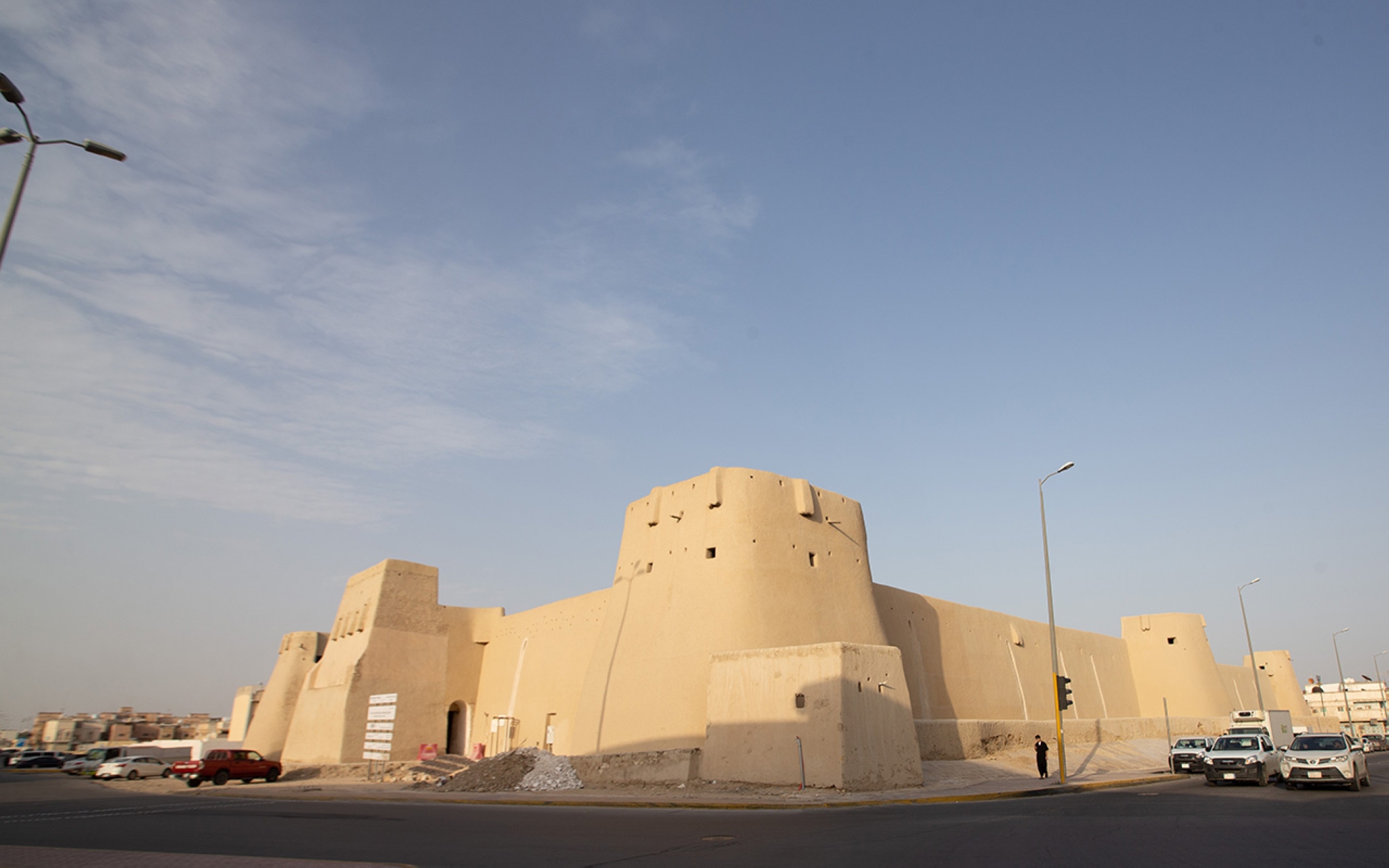
Sahoud Palace
It is a fortress built on a high plateau in the western part outside the ancient city of al-Mubarraz, facing al-Hazm Neighborhood in al-Mubarraz. The purpose of its construction was to protect the city and agricultural lands from raids. However, the exact date of its construction is unspecified, with an estimation between 1790 and 1800. The palace is surrounded by a low outer defensive wall, which was surrounded by a dry moat. The defensive walls of Sahoud Palace differ from other forts in al-Ahsa, as they include external and internal walls at the barricade level, as well as distinctive towers in terms of design.
Internal buildings are constructed along its western wall, and the main stairs are located next to the entrance. Inside, a spacious mosque is divided into two courtyards separated by three cylindrical stone columns. The mihrab and the minbar are located in niches within the palace’s wall. The palace was used as a defensive building for the city and the surrounding agricultural lands, as well as for monitoring the seasonal camps of the Bedouins. The name of the palace derives from a cannon that was installed inside, called Sahoud. The significance of Sahoud Palace emerged due to its location outside the new capital and its ability to defend against any attack coming from the north. In 1913, al-Ahsa was subject to Saudi rule, and some features of Sahoud Palace changed. In 1951, it became a military camp for soldiers. Recently, pieces of old war launchers were discovered while excavating during the restoration process of Sahoud Palace, as well as an old cannon and archaeological artifacts dating back hundreds of years.
Cultural heritage in al-Ahsa Oasis
Traditional architecture in al-Ahsa
The oases of al-Ahsa and al-Qatif are considered ancient regions in terms of construction. In these areas, castles and fortresses with high towers were built. Since the region is famous for its palm trees, palm fronds and trunks were used in roofing the buildings, as well as in the construction of doors and windows. Often, the locals would build their huts using palm trunks, fronds, and branches, as was customary in the villages of Dammam and al-Khubar, which were built by the Dawasir tribe following its migration there from Bahrain.
Among other building materials in this region is the silt clay brought from the sea or from holes specifically excavated for this purpose in the sabkhas. It was often mixed with hay to enhance its strength and cohesion. Locally extracted gypsum was used to plaster the walls of the buildings from the inside. They also used reeds and thatch for the buildings’ roofing. Most of the houses in al-Ahsa and al-Qatif consisted of a single floor with a small, narrow gate leading to a reception area (majlis) that was half-covered and half-open. This majlis served as a summer space that residents would cover with palm fronds and use as a small sitting area. Due to frequent sandstorms in the region, the majlis windows of these old buildings were characterized by being narrow and high.
Traditional markets
Al-Ahsa is known for its diverse traditional markets, including the 'Thursday Market,' held every Thursday morning in the market complex behind the government departments complex in the cities of al-Hufuf and al-Mubarraz. A wide variety of goods are sold there, such as vegetables, fruits, dates, trees, flowers, clothing, electrical appliances, antique tools, local handicrafts, some dry foods, pigeons, birds, and local chicken. The market is visited by a large number of Bedouins, as well as rural and urban residents.
Traditional markets are also organized throughout the week, each day in a different village: on Saturday in Hulaylah, Sunday in Al-Qarah, Monday in al-Jafr, Wednesday in al-Mubarraz and the town of al-Marah, and Friday in al-Tarf. Moreover, small traditional markets are organized in some of the modern neighborhoods in al-Hufuf and al-Mubarraz. Every Friday afternoon, the Haraj Market is held in al-Hufuf, where a variety of old, new, and used goods are sold at low prices.
Related quizzes
Related articles


